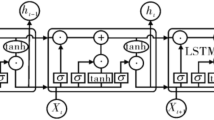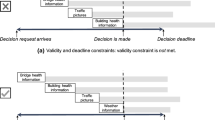Abstract
The time management model for event processing in internet of things has a special and important requirement. Many events in real world applications are long-lasting events which have different time granularity with order or out-of-order. The temporal relationships among those events are often complex. An important issue of complex event processing is to extract patterns from event streams to support decision making in real-time. However, current time management model does not consider the unified solution about time granularity, time interval, time disorder, and the difference between workday calendar systems in different organizations. In this work, we analyze the preliminaries of temporal semantics of events. A tree-plan model of out-of-order durable events is proposed. A hybrid solution is correspondingly introduced. A case study is illustrated to explain the time constraints and the time optimization. Extensive experimental studies demonstrate the efficiency of our approach.
Similar content being viewed by others
Explore related subjects
Discover the latest articles and news from researchers in related subjects, suggested using machine learning.References
Rodrigues P M M, Salish N. Modeling and forecasting interval time series with threshold models. Advances in Data Analysis and Classification, 2015, 9(1): 1–17
Zurita D, Delgado M, Carino J A, Ortega J A, Clerc G. Industrial time series modelling by means of the neo–fuzzy neuron. IEEE Access, 2017, 4: 6151–6160
Hu T, Lin X, Nan B. Cross–ratio estimation for bivariate failure times with left truncation. Lifetime Data Analysis, 2014, 20(1): 23–37
Prentice R L. Nonparametric inference on bivariate survival data with interval sampling: association estimation and testing. Biometrika, 2014, 101(3): 519–533
Drinkwater B, Charleston MA. A time and space complexity reduction for coevolutionary analysis of trees generated under both a yule and uniform model. Computational Biology and Chemistry, 2015, 57(C): 61–71
Fidaner I B, Cankorur–Cetinkaya A, Dikicioglu D, Kirdar B. CLUSTERnGO: a user–defined modelling platform for two–stage clustering of time–series data. Bioinformatics, 2016, 32(3): 388–397
Chen X, Worthington D. Staffing of time–varying queues using a geometric discrete time modelling approach. Annals of Operations Research, 2017, 252(1): 63–64
Ben Abdallah E, Ribeiro T, Magnin M, Roux O, Inoue K. Modeling delayed dynamics in biological regulatory networks from time series data. Algorithms, 2017, 10(1): 8
Al–Darabsah I, Yuan Y. A time–delayed epidemic model for ebola disease transmission. Applied Mathematics and Computation, 2016, 290: 307–325
Babu S, Srivastava U, Widom J. Exploiting K–constraints to reduce memory overhead in continuous queries over data streams. ACM Transaction on Database Systems, 2004, 29(3): 545–580
Hammad M A, Franklin M J, Aref WG, Elmagarmid A K. Scheduling for shared window joins over data streams. In: Proceedings of the 29th International Conference on Very Large Data Bases. 2003, 297–308
Liu C, Lu N, Zhang Q, Li J, Liu P. Modeling and analysis in a prey-predator system with commercial harvesting and double time delays. Applied Mathematics and Computation, 2016, 281: 77–101
Bashier E B M, Patidar K C. Optimal control of an epidemiological model with multiple time delays. Applied Mathematics and Computation, 2017, 292: 47–56
Mei Y, Madden S. ZStream: a cost–based query processor for adaptively detecting composite events. In: Proceedings of the 35th SIGMOD International Conference on Management of Data (SIGMOD). 2009, 193–206
Eder J, Panagos E, Pozewaunig H, Rabinovich M. Time management in workflow systems. In: Proceedings of the 3rd International Conference on Business Information Systems. 1999, 265–280
Chen J, Yang Y. Multiple states based temporal consistency for dynamic verification of fixed time constraints in grid workflow systems. Concurrency and Computation Practice and Experience, 2010, 19(7): 965–982
Fan C, Myint S W, Rey S J, Li W. Time series evaluation of landscape dynamics using annual landsat imagery and spatial statistical modeling: evidence from the phoenix metropolitan region. International Journal of Applied Earth Observation and Geoinformation, 2017, 58: 12–25
Wang H, Dai H, Fu B. Accelerated failure time models for censored survival data under referral bias. Biostatistics, 2013, 14(2): 313–326
Hai Z, Cheung T Y, Pung H K. A timed workflow process model. Journal of Systems and Software, 2001, 55(3): 231–243
Bettini C, Bettini X S, Jajodia S. Temporal reasoning in workflow systems. Distributed and Parallel Databases, 2002, 11(3): 269–306
Du S, Tan J, Lu G. The description and analysis of multi–granularity time restriction in the workflow model. Chinese Journal of Software, 2003, 14(11): 1834–1840
Liu M, Li M, Golovnya D, Rundensteiner E A, Claypool K. Sequence pattern query processing over out–of–order event streams. In: Proceedings of the 25th International Conference on Data Engineering (ICDE). 2009, 274–295
Song L P, Zhang R P, Feng L P, Shi Q. Pattern dynamics of a spatial epidemic model with time delay. Applied Mathematics and Computation. 2017, 292: 390–399
Grande R E D, Boukerche A, Alkharboush R. Time series–oriented load prediction model and migration policies for distributed simulation systems. IEEE Transactions on Parallel Distribution System, 2017, 28(1): 215–229
Kam P S, Fu A W. Discovering temporal patterns for interval–based events. In: Proceedings of the 2nd International Conference on Data Warehousing and Knowledge Discovery (DaWak). 2000, 317–326
Papapetrou P, Kollios G, Sclaroff S, Gunopulos D. Discovering frequent arrangements of temporal intervals. In: Proceedings of the IEEE International Conference on Data Mining. 2005, 354–361
Wu S Y, Chen Y L. Mining nonambiguous temporal patterns for interval–based events. IEEE Transactions on Knowledge and Data Engineering, 2007, 19(6): 742–758
Patel D, Hsu W, Lee M L. Mining relationships among interval–based events for classification. In: Proceedings of the 2008 ACM SIGMOD International Conference on Management of Data. 2008, 393–404
Acknowledgement
This research was partially supported by the Project of Shandong Province Higher Educational Science and Technology Program (J12LN05); the National Natural Science Foundation of China (Grant Nos. 61202111, 61472141, 61273152, 61303017); the Project Development Plan of Science and Technology of Yantai City (2013ZH092); the Doctoral Foundation of Ludong University (LY2012023); the Natural Science Foundation of Shandong (ZR2016FM15).
Author information
Authors and Affiliations
Corresponding author
Additional information
Chunjie Zhou received the PhD degree in computer science from Renmin University of China in 2011. She is currently a researcher and associate professor with the Department of Computer Science at Ludong University, China. She has published more than 30 academic papers in peer-reviewed international journals and conferences. Her research interests include big data, data mining, internet of things, and cloud computing.
Xiaoling Wang received the BS, MS, and PhD degrees from Southeast University, China in 1997, 2000, and 2003, respectively, all in computer science. She is currently a professor with East China Normal University, China. She has published more than 100 papers in peer-reviewed international journals and conferences, such as JWSR, JCST, SIGMOD, IJCAI, WWW, SIGIR, ICWS, DASFAA. Her current research interests include Web data management and data mining.
Zhiwang Zhang received the PhD degree in computer science from Chinese Academy of Sciences, China in 2009. He is currently a researcher and associate professor with the Department of Computer Science at Ludong University, China. He has published over 30 academic papers in various international journals and conferences. His research interests are in the areas of data mining and knowledge discovery, forecasting, machine learning, optimization, artificial intelligence and natural language processing.
Zhenxing Zhang received the BS degree in computer science from Shandong university of technology, China in 2005. He received his the MS degree and PhD degree from the IT collge, Gachon University of SouthKorea, in 2008 and 2012. He is currently an assistant professor in Ludong University. His research focuses on machine learning, biomedical prediction systems, multimedia content analysis and computational linguistics.
Haiping Qu received his PhD in Computer Science and Technology from the Institute of Computing Technology, Chinese Academy of Sciences (CAS), China in 2011. He is currently a lecturer in the School of Information and Electrical Engineering, Ludong University, China. His research interests include cloud computing and big data processing.
Electronic supplementary material
Rights and permissions
About this article
Cite this article
Zhou, C., Wang, X., Zhang, Z. et al. The time model for event processing in internet of things. Front. Comput. Sci. 13, 471–488 (2019). https://doi.org/10.1007/s11704-018-7378-4
Received:
Accepted:
Published:
Issue Date:
DOI: https://doi.org/10.1007/s11704-018-7378-4




